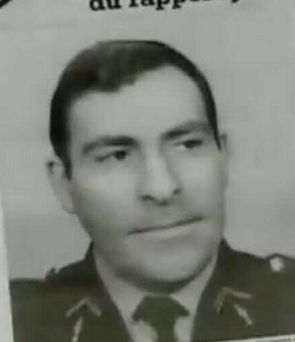Christian Jambert
(policeman) | ||||||||||||
|---|---|---|---|---|---|---|---|---|---|---|---|---|
 | ||||||||||||
| Born | November 26 , 1940 | |||||||||||
| Died | August 1997 (Age 56) | |||||||||||
Cause of death | "Multiple gunshot suicide" | |||||||||||
| Nationality | French | |||||||||||
| ||||||||||||
Christian Jambert was a French gendarme (policeman) who played a decisive role in the investigation of the case of the disappeared women from Yonne. He is also known for the disturbing circumstances surrounding his death from an alleged suicide, and how both the case of the missing girls and his "suicide" was connected to a powerful larger network of abusers.
Investigation of the disappeared from Yonne
- Full article:
 The Disappeared of the Yonne
The Disappeared of the Yonne
- Full article:
Between 1977 and 1979, seven rapes and murders were committed in Auxerre and the surrounding area. The victims were mildly mentally handicapped young women aged 16 to 27 from DDASS, a local institution. Over three decades, some 30 young women went missing while in the care of the social services in the Yonne region.[1]
As early as 1979, Jambert, who investigated the case, had suspected Émile Louis of being behind disappearances. On February 20, 1980, he became in charge of the file.
In 1984, Christian Jambert sent a report to the Auxerre public prosecutor's office implicating Émile Louis and a sado-masochistic pimping network in Yonne who exploited the girls of the DDASS. Émile Louis was charged for the murder of Sylviane Lesage, but the case was dismissed in 1984 despite the relationship he had with the victim, something demonstrated by Jambert. The same year, 1984, Jambert asked the deputy prosecutor of Auxerre, Daniel Stilinovic, for authorization to continue the investigation, but the case of the missing from Yonne was closed, despite the fact that Jambert again demonstrated links between Émile Louis and all of the missing.
The public prosecutor René Meyer did not open the a case, for lack of evidence, but informally asked the gendarme to continue the investigation. The report is misplaced and would not be found again until 1996.
In 2003, Stilinovic was removed from his position placed in automatic retirement, accused of having "misdirected" the 1984 gendarmerie report which established for the first time the list of the names of certain missing persons, each having a link with Emile Louis. Stilinovic successfully appealed the decision in 2012.[2]
Émile Louis was finally arrested, sentenced on appeal in 2006 in Paris to life imprisonment with 18 years of security and imprisoned until his death in 2013. Christian Jambert's contribution to the arrest of Émile Louis was unanimously recognized by all involved in the case. During the trial of Émile Louis, he was described by the gendarmes as an "outstanding investigator, a professional model and a remarkable personality".[3]
His death
On August 4, 1997, Christian Jambert was found lying in his garage, his .22 long rifle on the ground. He allegedly committed suicide with two bullets to the head, two days before his hearing as the main witness in the Émile Louis affair, a case linked to that of the tortured women of Appoigny, an investigation he had dedicated his attention to. [4]
A word of farewell, scribbled on a sheet of paper, is found nearby. Due to a lack of medical examiners available during this period of summer vacation, it is a doctor who does the post-mortem examination. He notes "two orifices", which may correspond to the points of "entry and exit" from a projectile, and a large wound on the back of the head. The body is then transported to the Auxerre University Hospital. There, another doctor quickly examines the body. No autopsy worthy of the name is done, and the Cazals prosecutor immediately gives a burial permit.
The file is closed until Isabelle, the daughter of Christian Jambert, intrigued by the developments in the Émile Louis affair, decides to request a new investigation into the "causes of death" of her father.
For more than a year, the gendarmes of the research section (SR) of Paris therefore tried to reconstruct the facts. This was not without difficulties since the seals of this file - the weapon used, the casings found in the garage and the powder samples taken from the body - had been destroyed, within the legal deadline, on the instruction of the Cazals prosecutor. They went discreetly in the Auxerre cemetery and exhumed the remains of their former colleague, who was transported to the Institut Médico-Legal in Paris. It only took the doctors a few minutes forensic experts to see the obvious: the two orifices on the gendarme's skull correspond at the entrances of two projectiles, fired at two different angles. In addition, debris of ammunition were found inside the skull, suggesting that one of the two bullets did not come out.[5]
In April 2004, the prosecution opens a judicial investigation against persons or persons unknown for assassination.
In February 2011, a dismissal is made of his death. "Contrary to what the ballistics expert from a first group of experts had asserted, the rifle found near the body, and whose operation had been modified by Christian Jambert so that the weapon could fire in bursts, could very well have been the one who had fired two bullets, the fragments of which had been found in the skull of the former gendarme," explained the prosecutor of Auxerre.
The gendarme's family appealed this ruling, which was confirmed by the Paris Court of Appeal in February 2012[6]. The family of Christian Jambert, through his lawyer, was appealing again.[update on the result of the appeal?]
References
- ↑ https://murderpedia.org/male.L/l/louis-emile.htm
- ↑ archived
- ↑ « Le gendarme Jambert, des "disparues de l'Yonne", s'est bien suicidé » arhcived
- ↑ http://www.leparisien.fr/faits-divers/cette-affaire-a-ete-sabotee-06-02-2002-2002795815.php
- ↑ archived
- ↑ http://www.bienpublic.com/cote-d-or/2012/02/17/non-lieu-confirme-dans-l-affaire-jambert